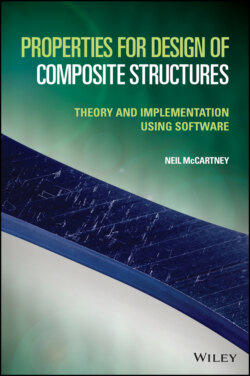Читать книгу Properties for Design of Composite Structures - Neil McCartney - Страница 30
2.14 Constitutive Equations for Anisotropic Linear Thermoelastic Solids
ОглавлениеAs we are concerned in this book with various types of composite material, it is necessary to define a set of constitutive relations that will form the basis for the development of theoretical methods for predicting the behaviour of anisotropic materials. Consider a general homogeneous infinitesimal strain εkl (applied to a unit cube of the composite material) defined in terms of the displacement vector uk and the position vector xk by (2.107), namely,
(2.143)
With the assumption that the strain field is uniform in the composite, the displacement field is linear and may be written in the form
(2.144)
where it is assumed that the displacement vector is zero when x1=x2=x3=0.
The local equation of state (2.111) is not of a form that can easily be related to experimental measurements as one of the state variables is assumed to be the specific entropy η. It is much more convenient, and much more practically useful, if the state variable η is replaced by the absolute temperature T. A local equation of state for the specific Helmoltz energy is assumed to have the following form (equivalent to (2.111) as implied by (2.67)–(2.69))
(2.145)
where εij is the infinitesimal strain tensor introduced in Section 2.12 (see (2.107)). For infinitesimal deformations, and because ψ≡υ−Tη from (2.64), the following differential form of (2.145) may be derived from (2.112)
(2.146)
where the specific entropy η and the stress tensor σij are now defined by
(2.147)
For infinitesimal deformations, a linear thermoelastic response can be assumed so that the Helmholtz energy per unit volume ρ0ψ^ has the form
(2.148)
where Cijkl are the elastic constants having the dimensions of stress or modulus, βij are thermoelastic coefficients and where T0 is a reference temperature. As the strain tensor is symmetric, it follows that βij=βji and that
(2.149)
(2.150)
(2.151)
On substituting (2.148) into (2.147), it follows that
(2.152)
(2.153)
It should be noted that the stress components are zero everywhere when the strain is defined to be zero everywhere at the reference temperature T0.
The inverse form of the linear stress-strain relations (2.153) is written as
(2.154)
where the compliance tensor Sijkl is such that
(2.155)
where use has been made of (2.15), and where
(2.156)
are anisotropic thermal expansion coefficients.
